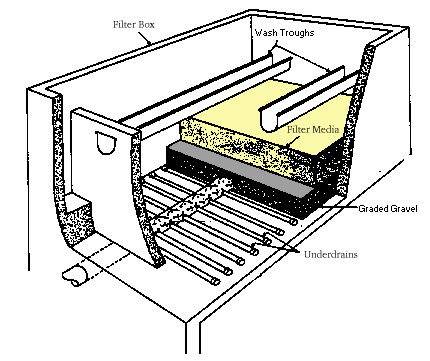Rapid sand / gravity filtration
| |
|
|
|
|
|
|
|
|
|
The rapid sand filter differs from the slow sand filter in a variety of ways, the most important of which are the much greater filtration rate and the ability to clean automatically using backwashing. The mechanism of particle removal also differs in the two types of filters - rapid sand filters do not use biological filtration and depend primarily on adsorption and some straining.
The filter is contained within a filter box, usually made of concrete. Inside the filter box are layers of filter media (sand, anthracite, etc.) and gravel. Below the gravel, a network of pipes makes up the under-drain which collects the filtered water and evenly distributes the backwash water. Backwash troughs help distribute the influent water and are also used in backwashing.
Most rapid sand filters contain a controller, or filter control system, which regulates flow rates of water through the filter. Other parts, such as valves, a loss of head gauge, surface washers, and a backwash pump, are used while cleaning the filter.
Filtration rate: 2-3 GPM/ft2
Filter Media: Sand. Or sand and anthracite coal. Or sand and anthracite coal and garnet.
Gravity or Pressure?: Gravity.
Filtration Mechanism: Primarily adsorption. Also some straining.
Cleaning Method: Backwashing.
Common Applications: Most commonly used type of filter for surface water treatment.
| Advantages | Disadvantages |
|---|---|
| - Relatively small and compact. | - Requires chemical pretreatment. Doesn't remove pathogens as well as slow sand filters. |
Construction, operations and maintenance
Operation of a rapid sand filter during filtration is similar to operation of a slow sand filter. The influent flows down through the sand and support gravel and is captured by the under-drain. However, the influent water in a rapid sand filter is already relatively clear due to coagulation/flocculation and sedimentation, so rapid sand filters operate much more quickly than slow sand filters.
Acknowledgements
- Types of Filters. Mountain Empire Community College.

